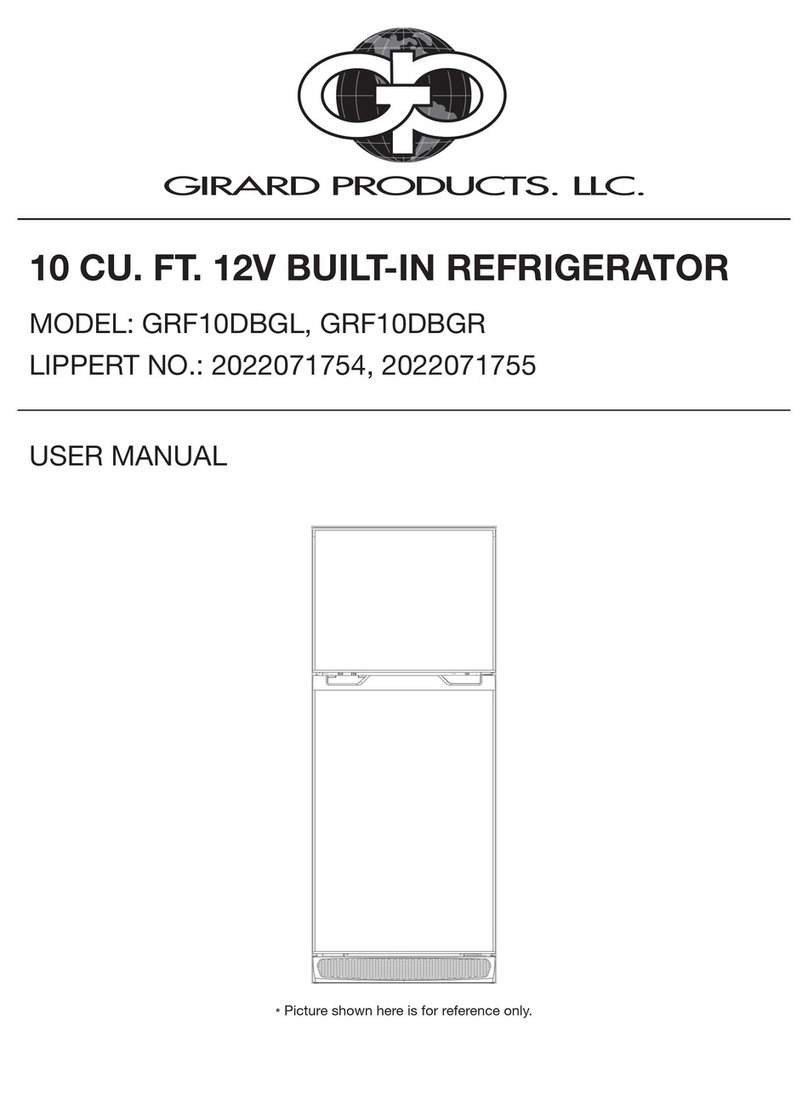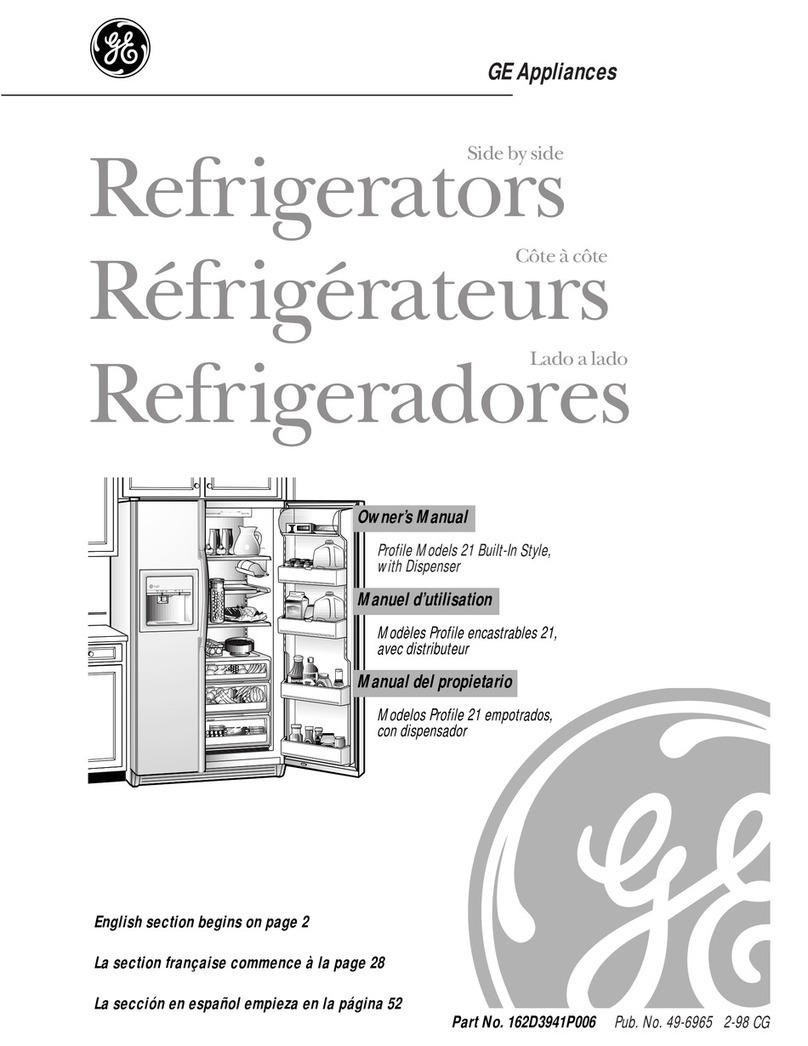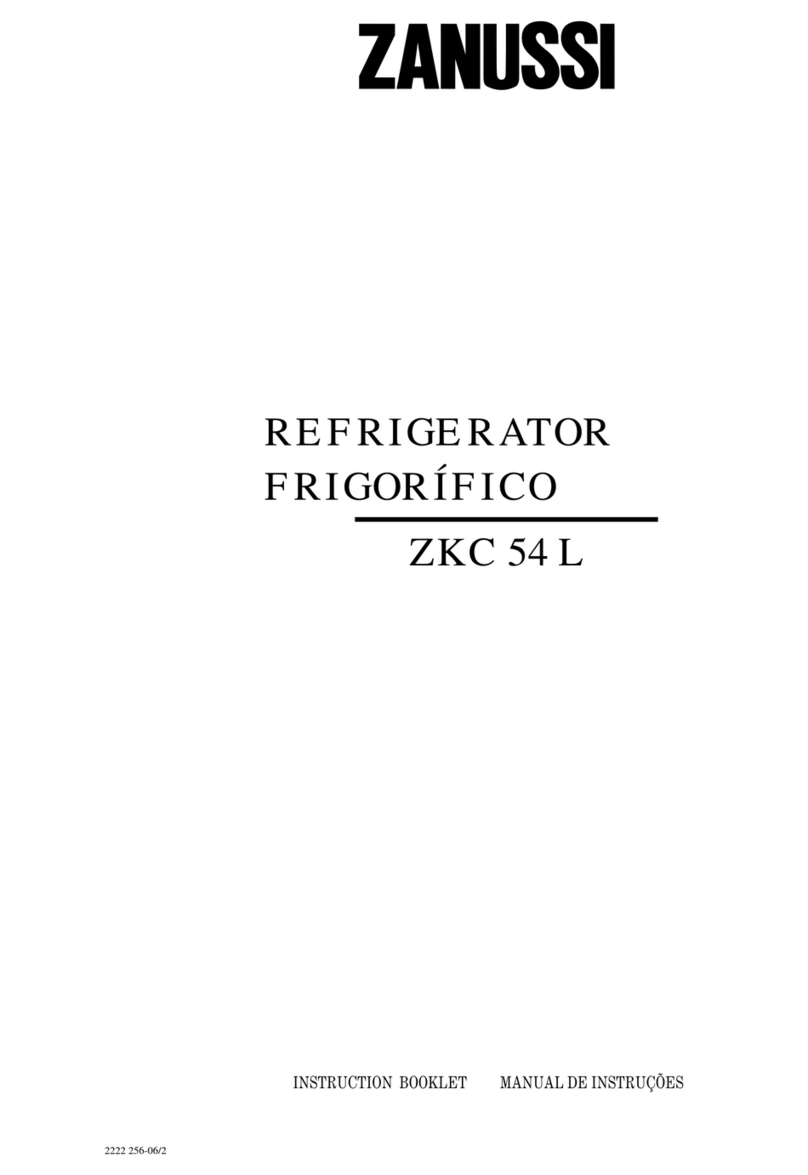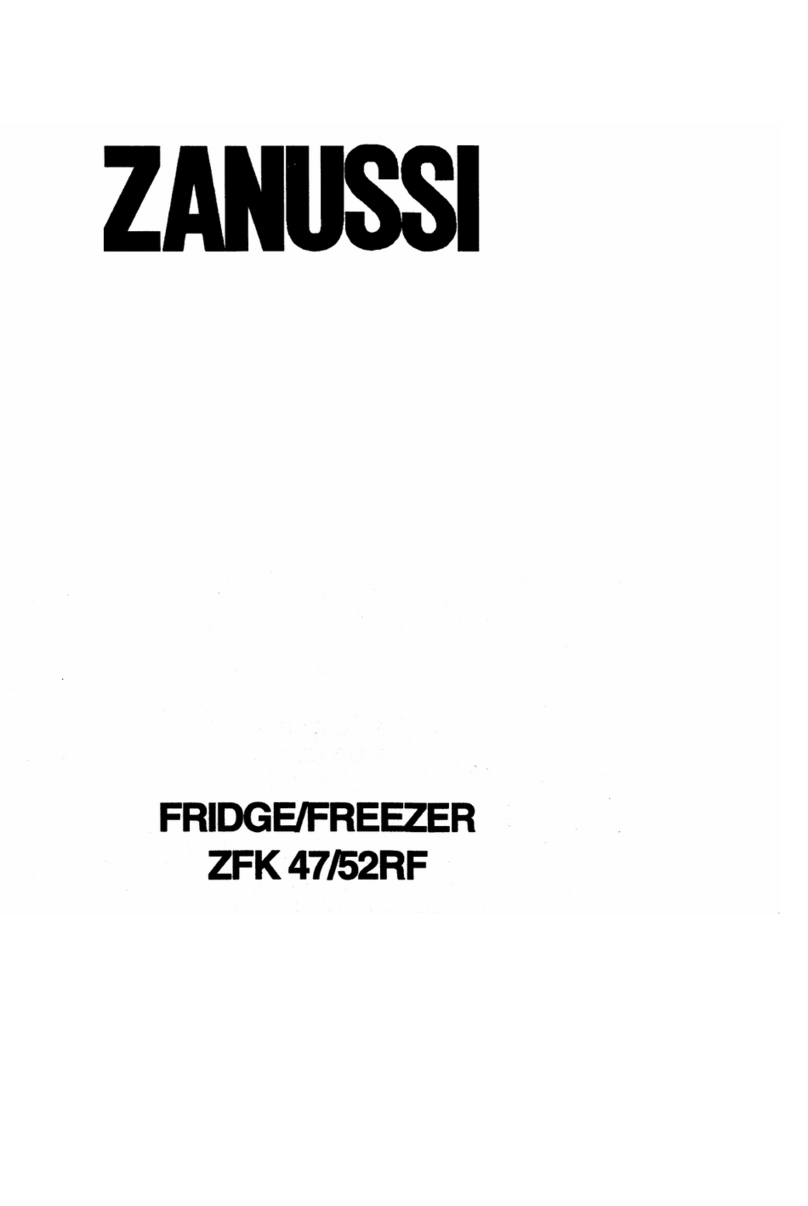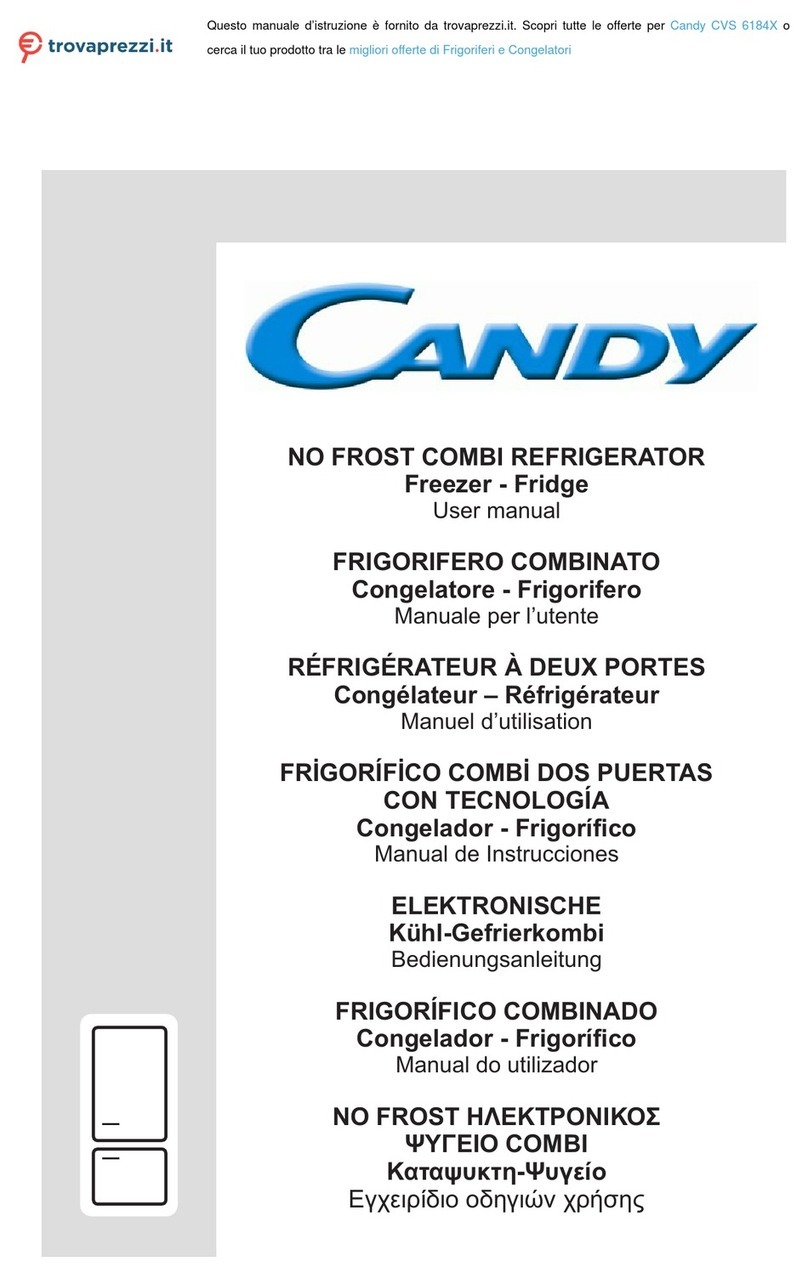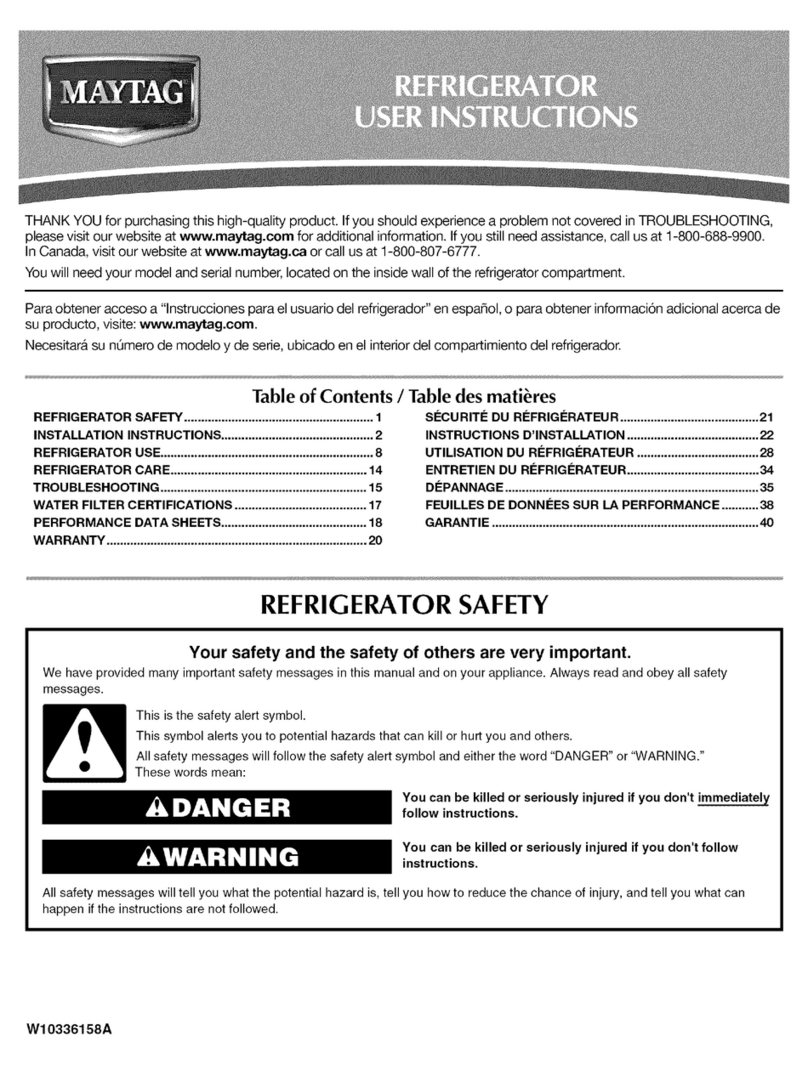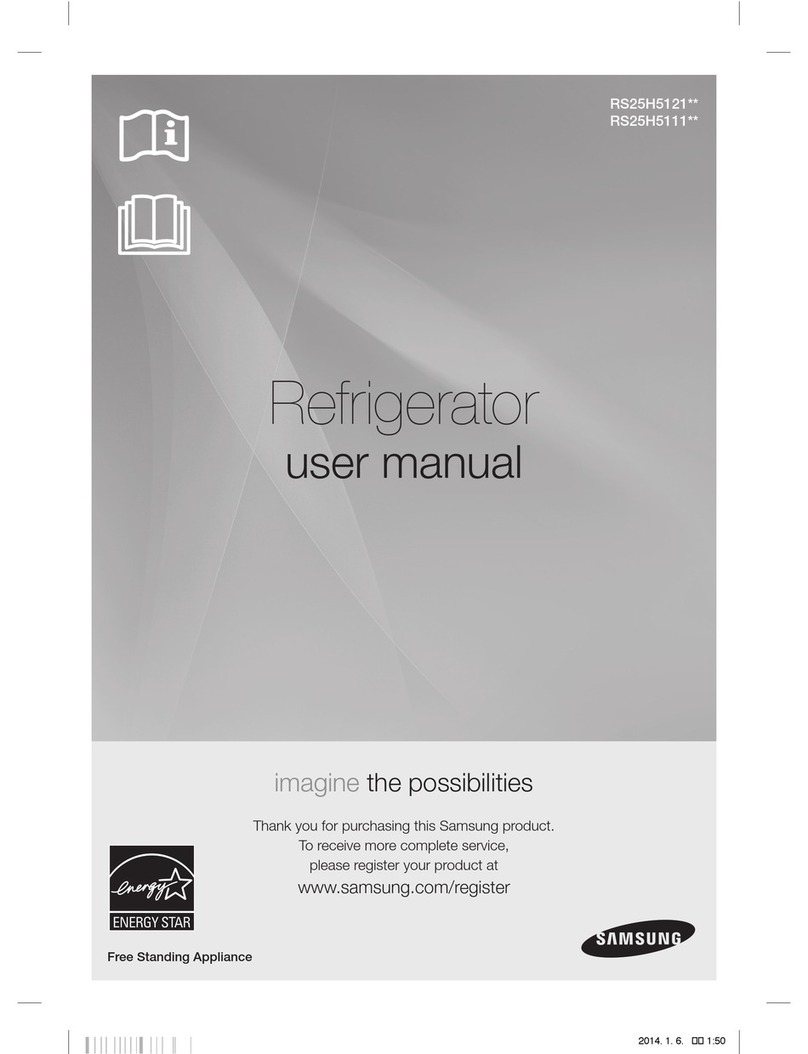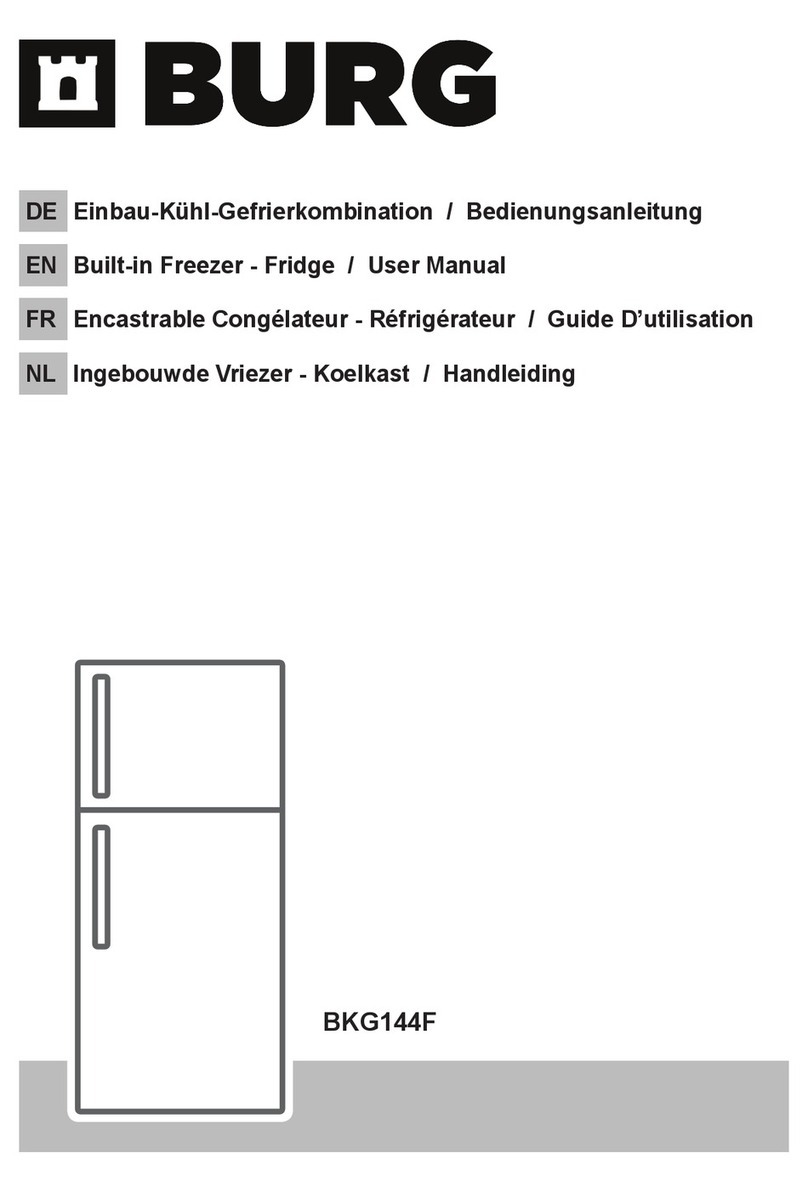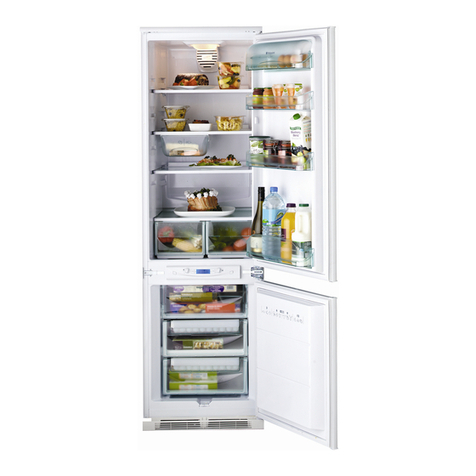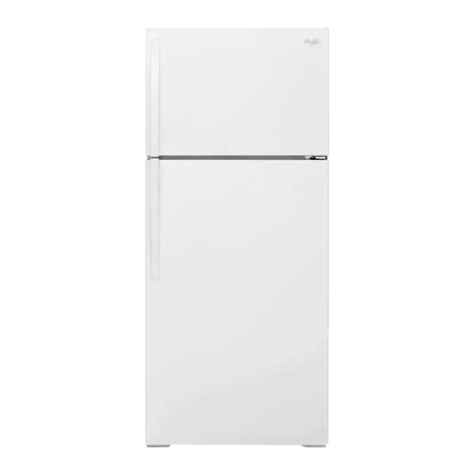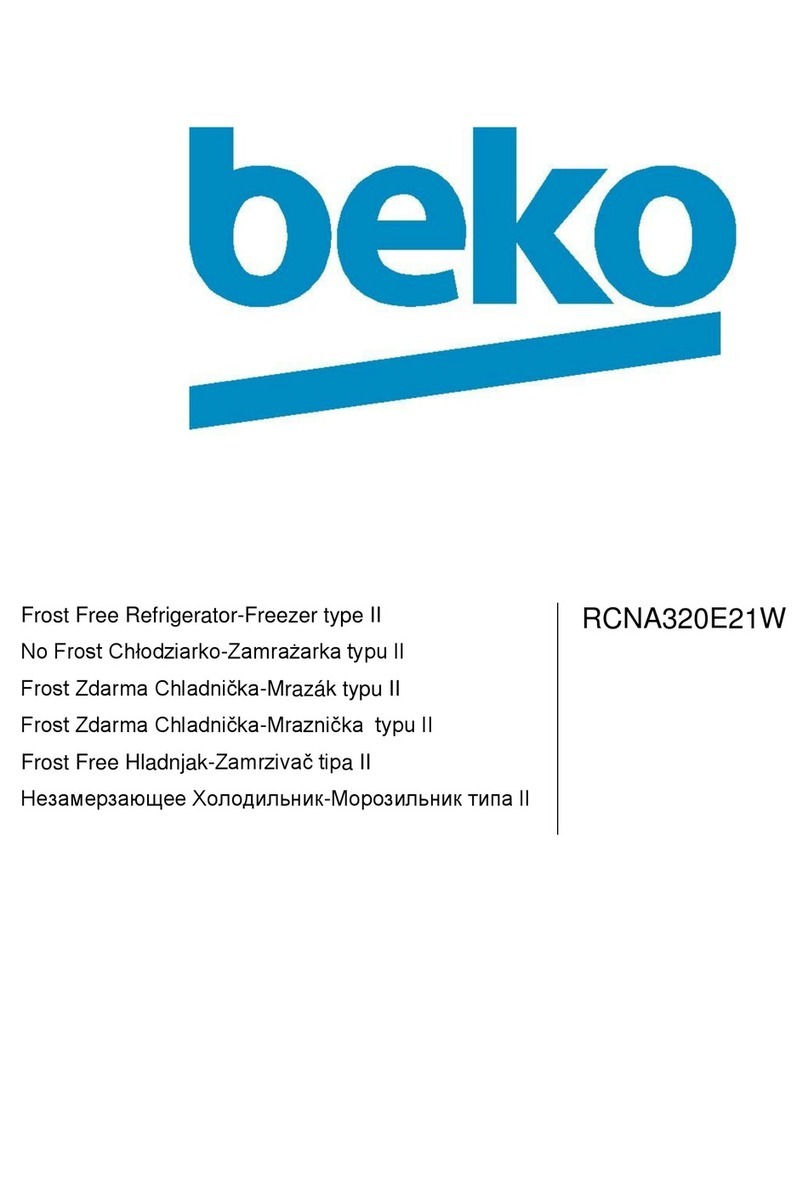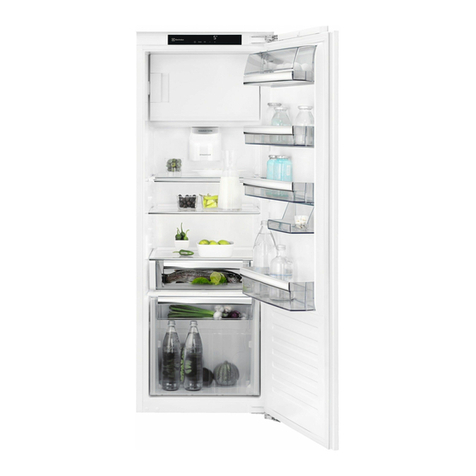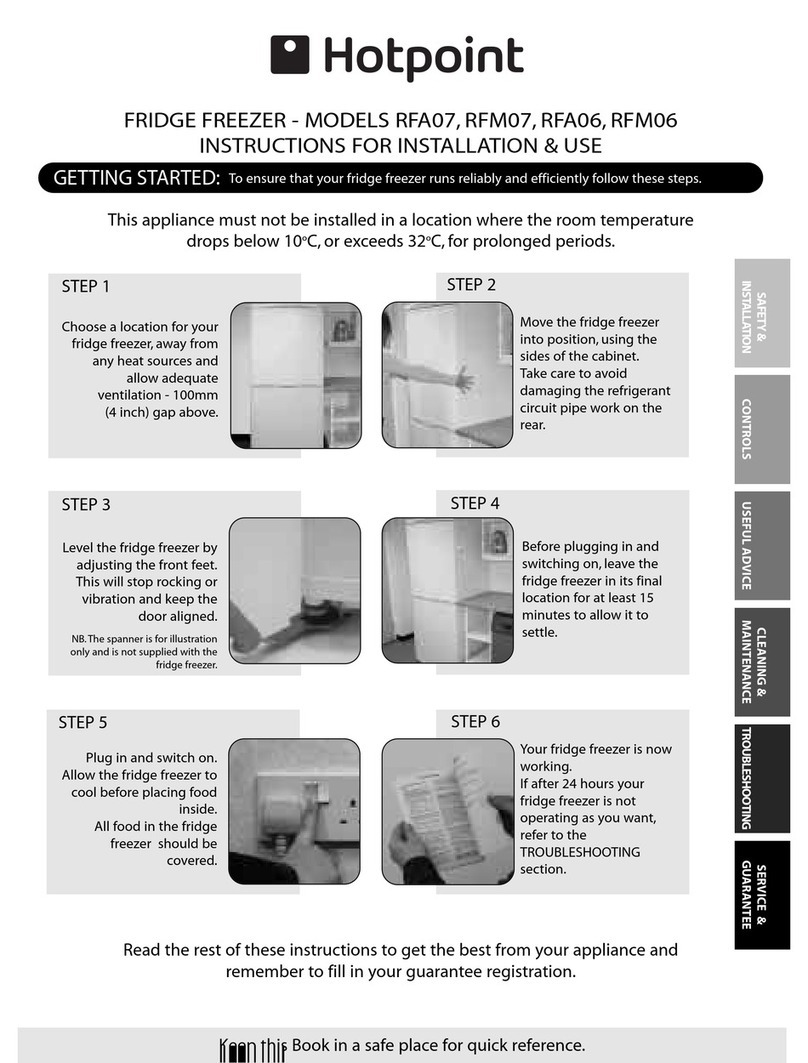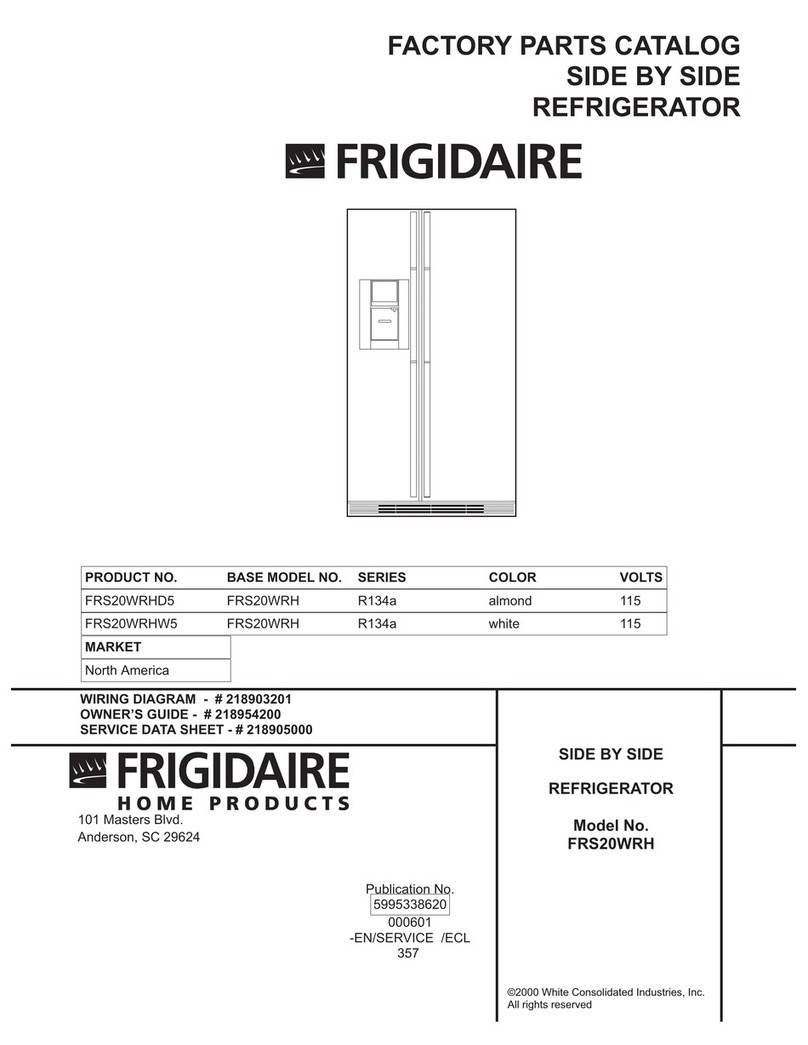Girard Products GRF16DBGS User manual

15.6 CU. FT. 12V SIDE BY SIDE DOOR REFRIGERATOR
GRF16DBGS [2022071756]
USER MANUAL
*Picture shown here is for reference only.

CCD-0005727 Rev: 09-22-22 - 1 -
Thank you and congratulations for purchasing this Girard product. Before operating your new product, please read these instructions carefully. This
instruction manual contains information for safe use, installation and maintenance of the product.
Please keep this instruction manual in a safe place for future reference. This will ensure safe use and reduce the risk of injury. Be sure to pass on this
manual to new owners of this product.
The manufacturer does not accept responsibility for any damages due to not observing these instructions.
Table of Contents
Table of Contents...................................................................................................................................................................................................1
Explanation of Symbols.........................................................................................................................................................................................2
Important Safety Instructions ...............................................................................................................................................................................2
General Safety ...................................................................................................................................................................................................2
Refrigerant.........................................................................................................................................................................................................2
Daily Use ...........................................................................................................................................................................................................2
Installation.........................................................................................................................................................................................................3
Service .............................................................................................................................................................................................................. 3
In Case of Malfunction ....................................................................................................................................................................................... 3
Remove Transport Packaging .............................................................................................................................................................................3
Correct Disposal of this product .........................................................................................................................................................................3
Product Overview .................................................................................................................................................................................................. 4
Installation.............................................................................................................................................................................................................4
What’s in the Box............................................................................................................................................................................................... 4
Before First Use .................................................................................................................................................................................................4
Specification...................................................................................................................................................................................................... 5
Site Preparation .................................................................................................................................................................................................5
Securing the Refrigerator...................................................................................................................................................................................6
Operation................................................................................................................................................................................................................7
Control Panel .....................................................................................................................................................................................................7
Function Selection .............................................................................................................................................................................................7
Controls.............................................................................................................................................................................................................8
Food Storage ....................................................................................................................................................................................................8
Accessories ......................................................................................................................................................................................................10
Cleaning and Maintenance....................................................................................................................................................................................10
Exterior Cleaning................................................................................................................................................................................................10
Interior Cleaning ................................................................................................................................................................................................10
Tips for Storage of Frozen Food..........................................................................................................................................................................11
Tips for Refrigeration ......................................................................................................................................................................................... 11
Traveling............................................................................................................................................................................................................11
At Power Failure.................................................................................................................................................................................................11
Energy Saving Tips ............................................................................................................................................................................................ 11
Troubleshooting .....................................................................................................................................................................................................12
Normal Phenomena ...........................................................................................................................................................................................12
Troubleshooting .................................................................................................................................................................................................13
Specification..........................................................................................................................................................................................................13

CCD-0005727 Rev: 09-22-22- 2 -
Explanation of Symbols
This manual has safety information and instructions to help you
eliminate or reduce the risk of accidents and injuries. Always respect all
safety warnings identified with these symbols. A signal word will identify
safety messages and property damage messages, and will indicate the
degree or level of hazard seriousness.
DANGER
Indicates an imminently hazardous situation which, if not avoided, will
result in death or serious injury.
WARNING
Indicates a potentially hazardous situation which, if not avoided, could
result in death or serious injury.
CAUTION
Indicates a potentially hazardous situation which, if not avoided, may
result in minor or moderate personal injury, or property damage.
Important Safety Instructions
General Safety
WARNING
●This appliance is intended to be used in household and similar
applications such as:
−Residential, mobile and recreational living homes.
−Staff kitchen areas in shops, offices and other working
environments;
−Farm houses and by clients in hotels, motels and other
residential type environments;
−Bed and breakfast type environments;
−Catering and similar non-retail applications.
●Do not store explosive substances such as aerosol cans with a
flammable propellant in this appliance.
●If the supply cord is damaged, it must be replaced by the
manufacturer, its service agent or similarly qualified persons in
order to avoid a hazard.
●Keep ventilation openings, in the appliance enclosure or in the
built-in structure, clear of obstruction.
●Do not use mechanical devices or other means to accelerate
the defrosting process, other than those recommended by the
manufacturer.
●Do not damage the refrigerant circuit.
●Do not use electrical appliances inside the food storage
compartments of the appliance, unless they are of the type
recommended by the manufacturer.
●The refrigerant and insulation blowing gas are flammable. When
disposing of the appliance, do so only at an authorized waste
disposal center. Do not expose to flame.
●When positioning the appliance, ensure the supply cord is not
trapped or damaged.
●Do not locate multiple portable socket-outlets or portable power
supplies at the rear of the appliance.
●To avoid a hazard due to instability of the appliance, it must be
fixed in accordance with the instructions.
Refrigerant
DANGER
RISK OF FIRE OR EXPLOSION
●Flammable refrigerant used. Do not use mechanical devices to defrost
refrigerator. Do not puncture refrigerant tubing.
●Flammable refrigerant used. To be repaired only by trained service
personnel. Do not puncture refrigerant tubing.
CAUTION
RISK OF FIRE OR EXPLOSION
●Flammable refrigerant used. Consult repair manual/owner’s guide
before attempting to service this product. All safety precautions
must be followed.
●Dispose of property in accordance with federal or local
regulations. Flammable refrigerant used.
●Risk of fire or explosion due to puncture of refrigerant tubing;
Follow handling instructions carefully. Flammable refrigerant used.
Risk of Fire
The refrigerant isobutane (R600a) is contained within the
refrigerant circuit of the appliance, a natural gas with a high
level of environmental compatibility, which is nevertheless
flammable.
●During transportation and installation of the appliance, be certain
that none of the components of the refrigerant circuit become
damaged.
●If the refrigerant circuit should become damaged:
−Avoid open flames and sources of ignition;
−Thoroughly ventilate the room in which the appliance is situated.
Daily Use
●This appliance is not intended for use by persons (including children)
with reduced physical, sensory or mental capabilities, or lack of
experience and knowledge, unless they have been given supervision
or instruction concerning use of the appliance by a person
responsible for their safety.
●Do not store flammable gas or liquids in the appliance as there is a
risk of an explosion.
●Do not operate any electrical appliances in the appliance (e.g.
electric ice cream makers, mixers etc.).

CCD-0005727 Rev: 09-22-22 - 3 -
●Do not place hot items near the plastic components of this appliance.
●Do not place food products directly against the air outlet on the rear
wall.
●Store prepacked frozen food in accordance with the frozen food
manufacturer’s instructions.
●The appliance manufacturers storage recommendations should be
strictly adhered to. Refer to relevant instructions for storage.
●Do not place carbonated or fizzy drinks in the freezer compartment
as it creates pressure in the container, which may cause it to
explode, resulting in damage to the appliance.
●Frozen food can cause frost burns if consumed straight from the
freezer compartment.
●Do not place the appliance in direct sunlight.
●Keep burning candles, lamps and other items with naked flames
away from the appliance as not to set the appliance on fire.
●The appliance is intended for keeping food stuff and/or beverages in
normal household as explained in this instruction booklet.
●The appliance is heavy. Care should be taken when moving it.
●Do not remove or touch items from the freezer compartment if your
hands are damp/wet, as this could cause skin abrasions or frost/
freezer burns.
●Never use the base, drawers, doors etc. to stand on or as supports.
●Frozen food must not be refrozen once it has been thawed out.
●Do not consume ice Popsicles or ice cubes straight from the freezer
as this can cause freezer burn to the mouth and lips.
●To avoid items falling and causing injury or damage to the appliance,
do not overload the door racks or put too much food in the crisper
drawers.
●Never cover or obstruct the ventilation slots on the appliance.
Installation
●For electrical connection carefully follow the instructions given in this
manual.
●Unpack the appliance and check if there are damages on it. Do not
connect the appliance if it is damaged. Report possible damages
immediately to the place you bought it. In this case retain packing.
●It is advisable to wait at least four hours before connecting the
appliance to allow the oil to flow back in the compressor.
●Adequate air circulation should be around the appliance, lacking
this leads to overheating. To achieve sufficient ventilation, follow the
instructions relevant to installation. Wherever possible the back of
the product should not be too close to a wall to avoid touching or
catching warm parts (compressor, condenser) to prevent the risk of a
fire, follow the instructions relevant to installation.
●The appliance must not be located close to radiators or cookers.
Service
●Any electrical work required to do the servicing of the appliance
should be carried out by qualified electrician or competent person.
●This product must be serviced by an authorized Service Centre, and
only genuine spare parts must be used.
In Case of Malfunction
●If a malfunction occurs on the appliance, please look first in the
“Troubleshooting” section of these instructions. If the information
given there does not help, please do not perform any further repairs
yourself.
●Under no circumstance should you attempt to repair the appliance
yourself. Repairs carried out by inexperienced persons may cause
injury or serious malfunctioning.
Remove Transport Packaging
The appliance and the interior fittings are protected for transportation.
Pull off the adhesive tape on the left and right side of the door. You
can remove any remnants of adhesive using mineral spirit. Remove all
adhesive tape and packing pieces from the interior of the appliance.
Correct Disposal of this product
WARNING
RISK OF CHILD ENTRAPMENT
Before you throw away your old refrigerator or freezer:
−Take off the doors
−Leave the shelves in place so that children may not easily climb
inside.
To prevent possible harm to the environment or human health from
uncontrolled waste disposal, recycle it responsibly to promote the
sustainable reuse of material resources. To return your used device,
please use the return and collection systems or contact the retailer
where the product was purchased. They can take this product for
environmental safe recycling.
●Redundant appliances should not be disposed of with normal
household waste but delivered to a collection and recycling center
for electronic equipment. A symbol shown on the product, the
instruction manual or the packaging shows that it is suitable for
recycling.
●Materials used inside the appliance are recyclable and are labeled
with information concerning this. By recycling materials or other
parts from used devices, you are making a significant contribution
to the protection of our environment. Information on appropriate
disposal centers for used devices can be provided by your local
authority.
●The packaging for this appliance is only necessary to provide
effective protection during transport. These materials can be
recycled where possible.

CCD-0005727 Rev: 09-22-22- 4 -
Product Overview
AB
6
Item Description
AFreezer Compartment
1Freezer Door Tray
2Freezer Glass Shelves
3Freezer Drawer
BRefrigerator Compartment
4Refrigerator Glass Shelves
5Refrigerator Drawer
6Refrigerator Door Tray
NOTE:
●Due to possible update of product from time to time, your refrigerator
may be slightly different from this User Manual, but its function and
operation remain the same.
●To get the best energy efficiency of this product, please place all
shelves, drawer and baskets on their original position as the User
Manual indicates.
Installation
WARNING
Before installing, read the instruction carefully for your safety and
correct operation of the appliance.
CAUTION
To avoid personal injury or damages at least 2 people are required for
the installation.
What’s in the Box
Make sure you have all the following items included in the packaging. If
any item is damaged or missing, contact your dealer.
●Refrigerator x 1
●User Manual x 1
●Warranty Manual x 1
Installation and service must be performed by a recommended installer,
service agency or electric supplier.
Before First Use
●Remove all packaging, including the foam backing at the bottom of
refrigerator and the tapes fixing accessories in the box.
●Place the refrigerator in a proper up-right position, let it stand up-
right for at least 4 hours before powering on.
●Remove the film: There is a layer of transparent film on the panel
surface to protect it from being scratched. You can choose to remove
or leave the film as needed.
●Review product specifications below to plan for proper clearances in
and around the enclosure.

CCD-0005727 Rev: 09-22-22 - 5 -
Specification
Front View Side View
Top View
D
A
E
G
H
F
AB
CC
Dimension
A3215/16
"
836mm E129/16"
319mm
B251/16"
636mm F13½"
343mm
C701/16"
1780mm G403/16"
1020mm
D59"
1498mm H2113/16"
554mm
NOTE:
●The product must be correctly installed, located and operated in
accordance with the instructions contained in the User Manual
provided.
●Parameters provided in table are design parameters. Because
of the various reasons, there will be a slight deviation between
actual dimension and design parameter. The data listed are only for
reference.
Site Preparation
Select Location
●Your new refrigerator must stand on a flat surface which should
support a weight of 529Lbs (240kg). Surface must be level relative
to the coach floor plane.
NOTE: A slope that is comfortable to live with, and from normal
transportation is acceptable.
●If the appliance is to be placed onto the carpet, support it with a
wooden board. Do not place the appliance directly on the carpet, as
the heat from the compressor may cause the carpet to fade.
●For best and most efficient operation, the refrigerator should
operate within 50°F ~ 109°F (10°C ~ 43°C). If installing near large
heat sources, such as furnaces, fireplaces, furnaces, etc. Ensure
a thermal barrier, such as wood paneling, isolates the refrigerator
space as not to hinder performance of the appliance.
Refrigerator Cabinet/Enclosure Preparation
●Position the appliance away from sources of heat such as stoves,
radiators, direct sunlight, direct weather such as rain, etc.
WMin. 337/8" (861mm)
HMin. 711/16" (1805mm)
DMin. 2413/16" (630mm)
H
D
W
Min. cabinet dimension
NOTE: Dimensions include
the required clearance for
venting.
Electrical Connection
WARNING
Any electrical work required to install this appliance should be carried
out by a qualified or competent person.
All Girard products referenced in this manual is to be installed in
accordance with local and national codes, including the latest editions of
the following standards:
USA:
−NFPA 1192
−NFPA 70
−ANSI/RVIA low Voltage
Canada:
−C22.1
−CSA Z240
The appliance is powered by Nominal DC 12V and must be supplied
at SAFETY EXTRA-LOW VOLTAGE circuit, a listed power converter that
conforms to UL 458 and/or C22.2 No. 107.1 is required.
Circuit Wiring Based on Voltage Drop:
Circuit wiring, gauge (AWG), length, and routing is to be determined by
the installer. It must not exceed a voltage drop at the appliance of more
than 4V DC.

CCD-0005727 Rev: 09-22-22- 6 -
To Measure:
Start the appliance from warm, isolate and measure the voltage
difference between each DC12V power source(s) and the appliance
connection. If the Voltage drop exceeds .4V DC, the length of wire should
be shortened, and/or Wire gauge (AWG) increased.
Circuit Rating: Min 20Amp, Max 40Amp. Do not share
circuit with any other utilization equipment.
NOTE: The circuit must be fused appropriately for the wire gauge (AWG)
used, within 18” of the DC 12V power source.
Only a single blow fuse or manual resettable breaker is allowed, auto-
resetting breakers must not be used. Do not add an additional fuse to
the pigtail end of the appliance.
The following is a starting guideline for wire sizing and should be
adjusted based on actual voltage drop:
●15ft or less = 10AWG
●15ft to 25ft = 8AWG
●25ft to 40ft = 6AWG
Installation TIPS:
●Voltage drop can be reduced by terminating the -12V (white) lead
directly to the vehicle chassis.
●-12V (white) and Ground (Green) leads can be combined at the
appliance or individually terminated.
Ground (Green)
-12V ( ) Supply Wire
Pigtail Harness
from Refrigerator
Not Provided
●Enter supply wire into the cabinet space. It is acceptable to enter
through the cabinet floor, sidewall, backwall or ceiling. Ensure that
the wire enters within the free cabinet space behind the refrigerator.
●Girard recommends dropping the 12V supply wire from the upper
ceiling or upper rear wall. Temporarily affix the wires to the upper
half of the appliance with tape so that excess wire will droop
without risk of rubbing with the appliance chassis and floor during
installation.
Drainage Preparation
The cavity condensate drainage is captured in a drain pan integrated
with the unit. No external drainage needs to be prepared at this point.
Securing the Refrigerator
WARNING
FIRE AND ELECTRICAL SHOCK HAZARD
●The appliance contains hidden refrigerant lines and electrical
wiring.
Follow all guidance in this section to prevent death, injury or property
damage.
For mobile applications, it is imperative to determine a sufficient
securing method to prevent sliding and tipping of the appliance during
transportation. Girard is not providing sufficient mounting methods, but
providing guidelines to consider when evaluating.
Body Mounting
WARNING
FIRE AND ELECTRICAL SHOCK HAZARD
DO NOT pierce screws into any surface of the refrigerator as there is a
risk of refrigeration leak or electrical shock hazard.
It is acceptable to use brackets to mount to the body’s front frame of the
fridge and the floor to hold the fridge in place.

CCD-0005727 Rev: 09-22-22 - 7 -
Top Restraints
●If restraints are used to mount or contact the top surface of the
appliance, avoid contact with the gray plastic electrical cover to
prevent damage. (Fig. 3)
Top View
Electrical Housing
Hinge Mounting
If using the hinge as a securing method (Fig. 1), support the bottom
of the hinge with a wood trim/block to prevent bending/damage to
the hinge. The wood block can also be used to choke the wheel from
moving. (Fig. 2).
⅞’’(21.4mm)
2⅞’’(72mm)
Fig. 2
Fig. 1
Leveling (Optional)
Screw the leveling feet
Fig. 3
into the bottom hinges in
appropriate depth until the
refrigerator is leveled. (Fig. 3)
Operation
Control Panel
●All functions and controls of the unit are accessible from a control
panel conveniently located on the front of the door. A display circuit
board allows easy configuration of features and settings in a simple
and intuitive manner.
●The display board consists of four buttons. You will hear a short beep
when you press the buttons.
●To ensure the normal operation of the refrigerator, we recommend
that when you start your refrigerator for the first time, set the
temperature of the refrigerator compartment to 41°F and the freezer
compartment to 0°F.
●However, the exact setting should be chosen keeping in mind that
the temperature inside is dependent on:
−Room temperature
−How often the door is opened
−Quantity of food stored
−Appliance location
NOTE:
●When the refrigerator starts up, it is in the default mode of Energy
Saving, which is to save energy and prolong the service life of LED
lights. The screen illuminates for 20s and then goes off.
Refrigerator
temperature display
Freezer
temperature display
Super fridge icon
O grid vacation mode
(Holiday Mode) icon
Lock/Unlock display
Refrigerator
temperature control
Freezer temperature
control
Super freezer icon
Function button
Lock/Unlock button
Function Selection
Press Function button to select operating mode following the sequence
of Off Grid Vacation Mode (Holiday Mode) > Super Freezer Mode >
Super Fridge Mode.
Stop cycling on desired setting to select mode. And the corresponding
mode icon will illuminate.

CCD-0005727 Rev: 09-22-22- 8 -
On/Off
●Long press Function button for 5 seconds to turn the refrigerator’s
LOW POWER mode on/off.
●Temperature displays illuminates with --, long press Function button
for 5 seconds to turn refrigerator back on.
Off Grid Vacation Mode (Holiday Mode)
In this mode, the refrigerator runs at 43°F and the freezer runs at 5°F.
Setting this mode can help conserve energy after disconnecting from
shore power, and using only DC12V power source and solar power
sources. Limit the frequency of door openings, and length of time open.
Sensitive foods should be consumed more quickly, and stored toward
the rear of the fridge to maintain freshness.
To optimize DC12V power source runtime performance:
●Ensure the refrigerator and food stored is down to desired
temperature before disconnecting shore power.
●Avoid adding significant amounts of warm items, especially
beverages, at one time unless already cooled.
●Adding new items is best in the morning to utilize solar power
(if available) during the day to bring the temperature back down
without consuming DC12V power source capacity.
Super Freezer Mode
When the Super Freezer Mode is selected, the compressor will operate
continuously to freeze foods faster, and keep them fresh. The super
freezer mode will automatically turn off either after 24 hours of operation
or when the freezer sensor reaches -18°F. The super freezer icon will
turn off, and the freezer will continue to operate at the last temperature
setting you have set before.
Super Fridge Mode
When the super fridge mode is selected, the fridge compartment
reaches the set temperature in the shortest period, in order to keep the
food as fresh as possible. In this mode, the set temperature of the fridge
compartment locks on 32°F.
The program runs 150mins then exits automatically, the super fridge
icon goes out,which means the super fridge function is disable, the
temperature setting returns to the last one before the super fridge mode
operates.
Controls
Fridge Settings
You can change the temperature or settings of the refrigerator
compartment by pressing the “Fridge” icon under the temperature
display.
The default temperature of the refrigerator compartment is 41°F. To
change the temperature press the “Fridge” button to cycle through the
set temperatures: 41°F > 39°F > 38°F > 36°F > 34°F > 32°F > 43°F.
Stop cycling when the desired setting is selected.
Freezer Settings
You can change the temperature or settings of the freezer compartment
by pressing the text ‘Freezer’ under the temperature display.
The default temperature of the refrigerator compartment is 0°F. To
change the temperature press the “Freezer” button to cycle through the
set temperatures: 0°F > -2°F > -4°F > -6°F > -8°F > -10°F > 5°F>
4°F> 2°F.
Stop cycling when the desired setting is selected.
Lock/Unlock
●This refrigerator is able to lock the control panel to stop accidental
operation.
●All buttons are locked if you press the Lock/Unlock button.
●The lock icon is illuminated when the control panel is locked.
●Hold the Lock/Unlock button for 3 seconds to Unlock. And the lock
icon is no longer displayed.
Open Door Alarm
When the refrigerator door is left open for more than 1 minute a buzzer
will alarm to remind you the door is open. After the door is closed, the
alarm sound will stop automatically.
Food Storage
IMPORTANT!
●When storing freezing foods, put them to the inside of freezer
chamber, other than the bottle rack.
●Do not put bottled or canned foods into the freezer chamber to
prevent frost cracking.
●Before putting hot foods into the refrigerator, cool them down to
room temperature first; otherwise, power consumption will increase.
●Mark the freezing date on the packaging bag according to different
storage lives of foods, so as to prevent foods from exceeding the
freezing time limit.
●Divide foods into proper pieces and package them separately so as
to freeze thoroughly and avoid being frozen together.
●The packaging materials shall be odorless, airtight, watertight and
pollution-free, so packaged foods are not tainted by other odor and
without quality reduction.
●Do not put too many fresh foods into the freezing chamber at once,
preferably not exceeding the freezing capacity value of refrigerator.
●Melted foods cannot be frozen again, unless they are made into
dishes; otherwise, their appearance will be affected.
●Glass bottles or containers shall not be placed into the freezer
chamber or at the air outlet of fridge chamber duct, otherwise they
may explode.
●Foods cannot block the air outlet, otherwise abnormal air circulation
will be caused.

CCD-0005727 Rev: 09-22-22 - 9 -
Refrigerator Chamber
The refrigerator chamber is mainly used to store foods that are
preserved for a short time.
The refrigerator chamber is suitable for storing fruits,vegetables,drinks
and other foods that will be consumed in a short period of time. It is
suggested to seal foods into a container and then put them into the
refrigerator.
Item Description
1Glass Shelves Drinks, Wheaten Foods, Milk, etc.
2Drawer Fruits, Vegetables, etc.
3Top Tray Dairy Products, Odorous Foods, etc.
4Bottle Rack Thin Packaged Foods, etc.
Freezer Chamber
The freezer chamber is used to freeze foods, store deeply frozen foods
and make ice cubes.
It can preserve foods for a long time.
The freezing chamber is suitable for retaining the freshness of foods
for a long time. When storing meat, it is suggested to cut the meat into
pieces which are easy to take out, and mark the freezing date to prevent
foods from exceeding the time limit.
Item Description
1Upper Bottle Rack Small frozen articles
2Glass Shelf Frozen foods such as fish, meat & ice cream
3Drawer Packaged Frozen Foods , etc.

CCD-0005727 Rev: 09-22-22- 10 -
Accessories
Fruit & Vegetable Box
The refrigerator chamber has a fruit and vegetable box, which can retain
the moisture of fruits and vegetables and keep the humidity of the box
properly. It is suitable for storing fruits and vegetables.(Fig. 7)
Glass Shelves
When removing shelving press the movable pin under the shelf with
both hands and push inward at the same time. Then the glass shelf will
be removed. (Fig. 8)
Fig. 7
line of cabinet
glass shelve glass shelve
line of cabinet
Fig. 8
Bottle Shelves
Disassembly: Hold both sides of the bottle shelf with both hands. Push
it from the side without the boss and push it inward as the direction of
the arrow. When pushing hard, please note that the buckle on the edge
of bottle shelf is separated from the groove of the liner. Then bottle shelf
can be removed.
Installation: Hold both sides of the bottle shelf with both hands. Install
the buckle of the boss side at first. Then push the other side inward
slightly, the buckle can be fixed. (Fig. 9)
Drawer of the Freezer Chamber
The upper drawer of freezer chamber can freeze and store large volume
foods, and the lower drawer is mainly used to store frozen foods. (Fig.
10)
line of door
bottle shelf
boss
Fig. 9 Fig. 10
CAUTION
To avoid damage of the liner, clean the fridge immediately when food
or liquids spills over. Oily liquids / food, like a soup can lead to cracks
or corrosion in the liner.
Cleaning and Maintenance
DANGER
ELECTRIC SHOCK!
Always disconnect power before cleaning or maintenance.
●Do not clean the appliance with metal objects, steam cleaner,
ethereal oils, organic solvents or abrasive cleansers.
●Do not use sharp objects to remove frost from the appliance.
●Use a plastic scraper.
Exterior Cleaning
CAUTION
Don’t use Thinner, Car detergent, Clorox, ethereal oil, abrasive
cleansers or organic solvent such as Benzene for cleaning as they
may damage the surface of the appliance and may cause fire.
To maintain good appearance of your appliance, you should clean it
regularly.
Wipe the digital panel and display panel with a clean, soft cloth.
Spray water onto the cleaning cloth instead of spraying directly on
the surface of the appliance. This helps ensure an even distribution of
moisture to the surface.
Clean the doors and cabinet surfaces with a mild detergent and then
wipe dry with a soft cloth.
IMPORTANT!
●Remove the food from the appliance before cleaning. Store them in a
cool place and well covered.
●Never clean the appliance with a steam cleaner. Moisture could
accumulate in electrical components.
Interior Cleaning
You should clean the appliance interior regularly. Follow the below steps:
●Remove all food.
●Wipe the inside of the fridge freezer with a weak solution of baking
soda, and then rinse with warm water using a wrung-out sponge or
cloth.
●Wipe completely dry before replacing the shelves and baskets.
Thoroughly dry all surface and removable parts.
Although this appliance automatically defrosts, a layer of frost may occur
on the freezer compartment’s interior walls if the freezer door is opened
frequently or kept open too long.
If the frost is too thick proceed as follows:
●Remove existing food and accessories baskets, switch off the power
supply of the refrigerator and leave the doors open.
●Ventilate the room thoroughly to accelerate the thawing process.
●When defrosting is completed, clean your freezer as described
above.
CAUTION
Only after the interior is completely dry the appliance should be
switched back on.
Defrosting
This appliance has an automatic defrosting function without manual
operation.
Door Seals Cleaning
Take care to keep door seals clean. Sticky food and drinks can cause

CCD-0005727 Rev: 09-22-22 - 11 -
seals to stick to the cabinet and tear when you open the door.
Wash seals with a mild detergent and warm water.
Rinse and dry it thoroughly after cleaning.
NOTE: Only after the door seals are completely dry the appliance should
be powered on.
Tips for Storage of Frozen Food
To obtain the best performance from this appliance, you should:
●Be sure that frozen foods are transferred from the food store to the
freezer in the shortest possible time.
●Do not open the door frequently or leave it open longer than
absolutely necessary.
●Once defrosted, food deteriorate rapidly and cannot be re-frozen.
●Do not exceed the storage period indicated by the food
manufacturer.
●Hot vapours can lead to the damage of plastic parts.
●Ethereal oils and organic solvents can attack plastic parts, e.g.
lemon juice or the juice from orange peel, butyric acid, a cleanser
that contain acetic acid. Do not allow such substances to come into
contact with appliance parts.
●Do not use any abrasive cleansers.
●Clean the appliance and the interior accessories with a cloth and
lukewarm water. Commercially available dishwashing detergents
may also be used.
●After cleaning wipe with fresh water and clean dishcloth.
●Check the water drain hole on the rear wall of the refrigerator
compartment. Clear a blocked drain hole with the aid of something
like a soft green peg, take care not to damage the cabinet.
●After everything is dry place appliance back into service.
Tips for Refrigeration
●Meat (all types): wrap in polyethylene (plastic) bags and place on
the glass shelf above the vegetable drawer. To avoid food poising
or contamination store meats properly wrapped for one or two days
only.
●Cooked foods, cold dishes; these should be covered and may be
placed on any shelf.
●Fruit and vegetables: thoroughly cleaned and placed in the special
drawer provided.
●Dairy: placed in aluminum foil or polyethylene (plastic) bags while
removing as much air as possible.
●Milk bottles: capped and stored in the bottle rack on the door.
Traveling
Your refrigerator is designed to operate during normal transportation
of your coach. Please refer to the following guidelines to assist during
transportation.
●Always travel with the doors closed and ensure will not open during
traveling.
●Avoid traveling with food in the cavity. Wait until you have arrived to
your destination and remove any remaining food before departing.
●Turn refrigerator to “OFF” (LOW POWER MODE) if climbing/crawling
any off-road grades. Compressor oil should resettle within 2 hours.
●Ensure the refrigerator has reached a desired stable temperature
before departing for your trip. Avoid storing temperature sensitive
items in the refrigerator while you are traveling unless a DC12V
power source power source is available. During towing, the
refrigerator can be operated as normal, as the tow vehicle should
charge the DC12V power source. See Off-grid Vacation Mode for
conserving power.
●Once you arrive at your destination, use the refrigerator as instructed
in this manual.
STORAGE / WINTERIZATION
●A DC12V power source maintainer should be used for long storage,
to keep a full charge.
●If the appliance is in storage, and not intended to be in operation,
disconnect power, clean the inside thoroughly, and leave the doors
propped open to avoid abnormal odors from developing.
●To prevent quick discharging of the batteries, the refrigerator can be
turned off to enter LOW POWER mode. Both the temperature displays
will show “--”. Press and hold the FUNCTION for 5 seconds to cycle
between ON/OFF.
●In LOW POWER mode, the interior lights, compressor and defroster
are turned off.
At Power Failure
●Generally, short-term power failure will not affect the temperature of
the refrigerator. However, if power failure lasts for a long time, you
shall reduce the opening frequency of refrigerator, and shall not put
fresh foods into the refrigerator (prevent rise in the temperature of
refrigerator from speeding up).
●If you know power failure is coming, you can turn on the “Super
Freezer” function in advance to keep the temperature of refrigerator
to the lowest value.
Shut Down
●Generally, it is not suggested to stop refrigerator or turn off the
power switch; otherwise, the lifetime of refrigerator may be affected.
Energy Saving Tips
●Make sure to keep the refrigerator away from heat sources and
direct sunlight.
●Before storing hot foods, cool them down to room temperature and
then put them into the refrigerator.
●Close the door timely, reduce the opening frequency, and shorten the
opening time.
●When unfreezing frozen foods, you can put them into the refrigerator
chamber, which will assist in refrigeration of the refrigerator
chamber.
●Make sure that the temperature sensor is not covered or blocked by
foods, and keep proper distance with foods.

CCD-0005727 Rev: 09-22-22- 12 -
Troubleshooting
WARNING
Before troubleshooting, disconnect the power supply.
IMPORTANT!
When the compressor is being turned on, the refrigerator creates some
sounds / noises, like gurgling - this is perfectly normal.
Repairs to refrigerators/freezers may only be performed by competent
service engineers. Improper repairs can give rise to significant hazards
for the user. If your appliance needs repairing, please contact your
specialist dealer or your local Service Centre.
Normal Phenomena
Phenomena Solution
Button Failure Please check the control board whether the fridge is in lock mode. When in Lock mode, all buttons can’t work.
Low voltage, the
compressor can’t start Charge the RV-batteries by connecting the RV to the shore power.
Long time to start When the surrounding ambient temperature is high, it will take a while to feel the compartments cooling.
Middle beams feel hot Middle beams feel hot after a period of time of the appliance run, it is a normal phenomenon.
Dew drops
When external air flows into the cool inner surface of the fridge, dew drops can be formed.
If the humidity of the installed location is high or during the rainy season, dew drops can form on the outer side of the fridge. This is a natural
phenomenon that occurs during the humid weather, Wipe the water drops with a dry cloth.
Noise
When you operate the fridge for the first time, the fridge will operate at high speed to cool fast and the sound can seem louder. When the internal
temperature falls below a certain level,the noise will subside.
When the compressor is starting up, or stopping, various parts may expand or contract. This may generate some audible sounds, noises, which are
perfectly normal.
Compressor hot When working, the temperature of the compressor housing may rise to more than 176°F - please do not touch the compressor, it may cause serious
injury.
Compressor long time
running
When the ambient temperature is too high or put too much fresh foods into the fridge, it will take long time to cool down until the appliance runs at the
setting temperature.
Light is not working Contact Manufacturer
If door has been left open too long lights will be deactivated. Close & reopen the door to activate
Middle beam feels hot Normal phenomenon.
Both the temperature
displays show “--” and
interior lights are off
The refrigerator is in Low Power mode. Press and hold the Function button for 5 seconds to exit the Low Power mode

CCD-0005727 Rev: 09-22-22 - 13 -
Troubleshooting
Before contacting the Girard Customer Service:
1. Try to solve the problem yourself following the points described in the table below.
2. Turn off the appliance and restart it to see if the fault persists.
Trouble Possible Cause Solution
No display on the
display panel
Appliance is not switched on Switch on the appliance.
RV batteries are empty. Recharge the DC12V power source (by connecting RV to the shore power).
Fuse is blown or defective Check fuse, replace if necessary.
DC connecting wires are intermittent / broken Such malfunctions are to be corrected by an electrician.
Alarm sound
Door is slightly open or not closed fore more than 1 minute
Close the door completely.
Compressor doesn’t
work
Under defrosting mode Normal for defrosting.
DC12V power source voltage is too low or DC12V power
source is too weak. Charge / replace DC12V power source.
Vibrating noise
Floor is uneven or week Be sure the floor is even and solid and can adequately support the fridge.
Items placed on the top of the fridge are vibrating Remove items.
Fridge touches the wall or cabinet Move fridge so that it does not touch the wall or cabinet.
Layer of Frost in
compartment
Blocked air outlets Check air outlets not blocked, ensure food placed in appliance has sufficient
ventilation
Doors can’t be
closed easily Blockage •Check nothing internal is trapped in the door.
•Tilt the refrigerator back to allow self-closing mechanism
Light is not working
Damaged LED Contact Manufacturer
Control system disabled lights If door has been left open too long lights will be deactivated. Close & reopen
the door to activate
Specification
Specifications
Total Capacity 15.6 cu. ft. (442L)
Freezer Capacity 6.08 cu. ft. (172L)
Fridge Capacity 9.54 cu. ft. (270L)
Noise (dB) ≤42dB
Door Type Side by Side
Handle Recessed Handle
Control Type LED Display with electronic control
No. of Shelves 6
No. of Crisper 4
Cooling Type Compression cooling system
Specifications
Refrigerant R600a
Rated Voltage DC 12V
Rated Current 19A (≤ 20A)
Power Consumption 667kWh/year
Off-Grid Rating 5.3Ah @ 77°F (25°C)
Temperature Range Refrigerator: 32°F to 43°F (0°C to 6°C) adjustable
Freezer: -10°F to 5°F (-23°C to -15°C) adjustable
Working Temperature
Range 50°F to 110°F (10°C to 43°C)
Defrost Automatic
Certification CSA

CCD-0005727 Rev: 09-22-22

IM-FHA00121 V3.0
CCD-0005727 Rev: 09-22-22
The contents of this manual are proprietary and copyright protected by Lippert. Lippert prohibits the copying or
dissemination of portions of this manual unless prior written consent for an authorized Lippert representation
has been provided. Any unauthorized use shall void any applicable warranty. The information contained in this
manual is subject to change without notice and at the sole discretion of Lippert. Revised editions are available
for free download from lippert.com.
Please recycle all obsolete materials.
For all concerns or questions, please contact Lippert
This manual suits for next models
1
Table of contents
Other Girard Products Refrigerator manuals
